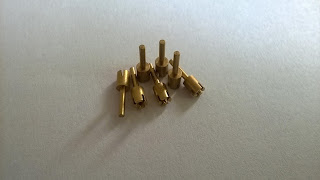Signal Cable Connections
The chain must be completed and have high integrity to provide the
communication path for control signals to pass over. Depending on the specific
design of the programmable control system, loss of communication to the I/O system
will cause a critical failure, stopping the CPU scan .cnc machining parts In other systems,
configurations can be accomplished that allow the unaffected portions of the
programmable controller system to continue to operate.
As
we saw earlier, communication between chassis can either be parallel or serial.
Parallel communication uses multiple conductors to pass all bits of a byte or
word of data simultaneously. Serial communication provides a method for single
bits of a byte or word of data simultaneously. Serial communication provides a
method for signal bit of a byte or word to be transmitted sequentially. The
difference this has on cable design and selection is significant. Parallel
cables are made of as many as 16 or more pairs of twisted individual
conductors, protected by a shielded external jacket. cnc machining parts Multiple pin connectors
are connected to one or both ends of the cable. The "D" type is
popular, providing 25 or 39 pins in a standard configuration. Earlier design
used a round type positive contact threaded design and certain manufactures
still use this type of connector, although most have found the "D"
type satisfactory.
This
cable is normally made available by the programmable controller manufacturer,
and while it may seem expensive, the assurance of having a well-designed and
thoroughly tested cable is worth almost any price compared to tracking down an
intermittent problem later during a critical production period. The
programmable controller manufacturer will provide parallel cables designed to
operate with its equipment in various lengths, from 2 ft (feet) up to as much
as 500 ft. Serial cables on the other hand are generally easier to use and less
expensive to purchase or build. Manufacturers may or may not provide these as
an item to purchase, and may just refer the purchaser to a third party source.
Serial signal cable is normally a single or dual twisted pair of conductors,
and is often just connected directly to the I/O driver or receiver with screw
terminals. The only major reason to use parallel over serial is the great
communication speed available with parallel, which can be a factor of 10 to 1,
or more.
Troubleshooting and Repair
Even the best of today’s well-designed and manufactured programmable
controllers require occasional preventative maintenance and repair. This
section looks at some of the tools provided by the manufacturer and techniques
for general maintenance.
Most of the medium- and large-sized programmable controller systems
available today are designed to be maintained by individuals with a wide
variety of skills, without the benefit of in-depth formal training of this
piece of equipment. This is accomplished in the design by providing individual
modules of functionality installed in a chassis serviced from the front (all
module types including power supplies). Front access is critical to proper
maintenance. This allows easy inspection and replacement of the suspected bad
module. Module health is determined by inspecting the LED indicators normally
provided on the front of each module. Typical indicators will be on or off
depending on the design and individual condition of the module in question.
Various CPU and I/O modules will have indicators showing I/O control
communications status, memory integrity, power supply tolerance check, scan
integrity, and others. On future controller designs, and even today on a few
systems, it is likely that English language messages will be displayed on the
controller advising the user or maintenance personnel that a particular failure
has occurred and recommended actions to take.
The
modular design and diagnostic indicators are, of course, important, but would
be quite useless without well designed documentation provided by the
manufacturer for the programmable controller system in question. Proper
documentation will have sections dedicated to each major subsystem including
CPU, I/O, and programming device. Each should explain in depth the stop-by-stop
inspection of the system. All possible combinations of failure mode should be
listed, along with suggested actions for repair. This will most often involve
only the substitution of a re- placement board for the suspected failed unit.
The user is urged to purchase a set of spare modules for the system in question
as recommended by the manufacturer. This is normally, at a minimum, a single
replacement module for each CPU and programming device serviceable module, and
spare I/O modules equal to 10% of the number in the system.
While the design of system and documentation provide an easy vehicle for
system maintenance once trouble is detected, it is always better to perform
preventative maintenances where possible. Some systems available today provide
levels of predicted failure detection that allow excellent preventive
maintenance.
This
can range from automatic singling of low battery conditions on the memory
modules to predicting an output circuit failure before the circuit is
energized. This particular phenomenon can be extremely valuable in performing
predictive maintenance on critical systems. Examples of this would include
emergency circuits for rapid shutdown of a machine sequence or plant process.
Outputs that fail prior to their need may not be detected in time to provide
this critical service.
The
documented ladder logic diagram is a very useful tool for troubleshooting,
especially on a complex system. It allows maintenance personnel or "walk
through" the I/O segment in question, forcing transitions in specific
inputs and outputs, while watching the system's reaction. cnc machining parts Many times this can
ferret out a tough system problem, and may help isolate problems external to
the controller such as an open sensor wire.
The major manufactures of programmable controller systems maintain 24 h
telephone service numbers for users requiring emergency, service. Their highly
trained personnel can normally walk the user through his problem and determine
what action he should take for repair.







